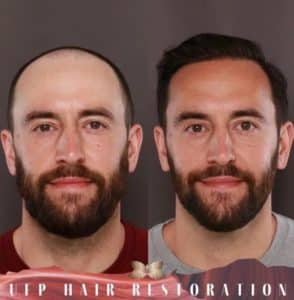A little over a year ago a 33-year-old male patient came in to see Dr. Thompson at UFP Hair Restoration to discuss hair loss and restoration options. He felt like his hair loss was making him appear older and left him feeling less confident about his overall appearance. He also noticed that his hair loss pattern was established and that it had plateaued. This patient first started noticing hair loss around 20-24 years old. Like many men suffering from hair loss, his hair loss first occurred around the hairline, frontal area, and temples. During this time, he noticed that his hair loss was slow and steady until he was almost 26 years old. After years of suffering from hair loss, he was ready to do something about it.
Ideal Hair Restoration Candidate
This individual was an ideal candidate for hair restoration surgery because he was out of the beginning stages of hair loss, which is typically under 30 years old. Hair restoration surgery is not recommended for those in the early stages of hair loss because hair loss has generally not plateaued. If you are unfamiliar with hair transplant surgery, it relies on harvesting “donor grafts” which are taken from the back of the patient’s head and transplanted to the thinning or balding areas. If a hair transplant is done early, the patient risks distributing too much hair to areas that may not be as affected by hair loss, leaving curtain areas of the scalp looking too dense. This patient was at the point in his hair loss journey that Dr. Thompson was able to determine his hair loss pattern and severity.
Which Hair Transplant Procedure Is Right For Me?
In this particular situation, Dr. Thompson met with this patient and determined that the he was a candidate for either FUT (Follicular Unit Transplant) or FUE (Follicular Unit Extraction). The decision was ultimately up to the patient. After careful consideration, this individual chose to undergo the FUT hair restoration surgery.
FUT or more commonly referred to as “the strip method” involves a strip of the scalp from the back of the head to be excised, which results in a linear scar on the back of the head. This scar can be easily camouflaged with slightly longer hair. This patient had good skin laxity and did in fact style his hair long enough to cover the linear scar.
How Many Grafts Were Transplanted?
Dr. Thompson recommended using 1800 Grafts to recreate the hair density he once had. These grafts were placed across the hairline, frontal area, and temples. The number of grafts is unique to each individual patient depending on the severity of their hair loss.
Hair Transplant Results

After a year from surgery, this patient was extremely happy with his results, and they do speak for themself. The after photos are just 12 months following his FUT hair restoration surgery, which it does take 9-12 months on average for final results. He had an extremely high take rate and now has much more hair density. Check out more hair restoration before and after photos here. The patient was eager and kind enough to share his thoughts and experience as well.
Hair Restoration Patient Review Video
“I was looking for an experienced team to do my FUT hair transplant surgery and I ended up finding Dr. Thompson and the team over at Utah Facial Plastics. They were awesome! They were legit amazing. Everything from the quickness and the efficiency of the team and how painless it was, and more importantly like the results are actually amazing. I actually look a few years younger now than I did before and a lot of the confidence that I used to have is back from my early youth and I couldn’t be happier with the results.” – Nick S.
If you are someone who is looking into hair loss solutions or hair restoration options and would like to schedule an individual consultation, please contact our Draper or Layton, Utah office at 801.849.8140. UFP Hair Restoration surgeons and providers are highly experienced and specialized to address your surgical or non-surgical hair loss needs.